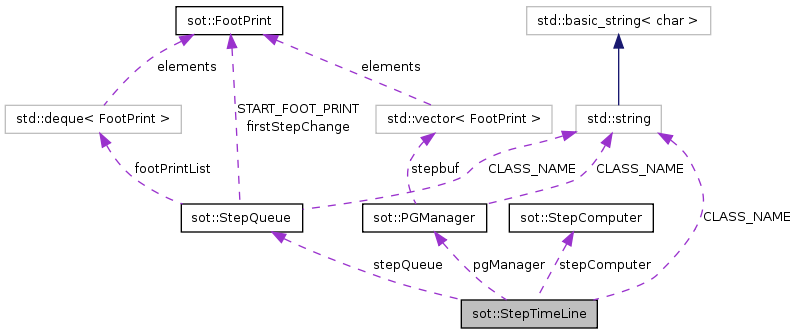sot::StepTimeLine Class Reference
Synchronizes the components for the automatic step generation. More...
#include <sot-pattern-generator/step-time-line.h>

Public Member Functions | |
| virtual const std::string & | getClassName (void) const |
| StepTimeLine (const std::string &name) | |
| int & | triggerCall (int &dummy, int timeCurr) |
| The trigger callback function, which implements the synchronization of all the sub-components used to generate and send the steps. | |
| virtual void | display (std::ostream &os) const |
| virtual void | commandLine (const std::string &cmdLine, std::istringstream &cmdArgs, std::ostream &os) |
Public Attributes | |
| dg::Signal< int, int > | triggerSOUT |
| Trigger signal, to be updated periodically to trigger a call to the synchronization method. | |
Static Public Attributes | |
| static const std::string | CLASS_NAME |
Detailed Description
Synchronizes the components for the automatic step generation.
This entity automatically generates steps to send to a PatternGenerator entity. The responsibility of this entity is to synchronize all the components that are used to generate and send the steps, by triggering them at the appropriate time.
This entity accepts the following shell commands:
- state: stepper.state will print the current state of the timeline, stepper.state start will start the stepping, stepper.state stop will stop the stepping.
The possible states of the timeline are the following:
- starting: playing an initial step sequence (warmup),
- started: generating steps using the StepComputer,
- stopping: playing a final step sequence (cleanup),
- stopped: doing nothing (not sending steps).
- Note:
- {This entity class can not be instantiated in a shell since it does not / register any factory. This behavior is intended.}
Constructor & Destructor Documentation
| sot::StepTimeLine::StepTimeLine | ( | const std::string & | name | ) |
Member Function Documentation
| virtual void sot::StepTimeLine::commandLine | ( | const std::string & | cmdLine, | |
| std::istringstream & | cmdArgs, | |||
| std::ostream & | os | |||
| ) | [virtual] |
| virtual void sot::StepTimeLine::display | ( | std::ostream & | os | ) | const [virtual] |
| virtual const std::string& sot::StepTimeLine::getClassName | ( | void | ) | const [inline, virtual] |
| int& sot::StepTimeLine::triggerCall | ( | int & | dummy, | |
| int | timeCurr | |||
| ) |
The trigger callback function, which implements the synchronization of all the sub-components used to generate and send the steps.
Member Data Documentation
const std::string sot::StepTimeLine::CLASS_NAME [static] |
| dg::Signal< int,int > sot::StepTimeLine::triggerSOUT |
Trigger signal, to be updated periodically to trigger a call to the synchronization method.
Typically, this signal is added to the periodic calls of OpenHRP.